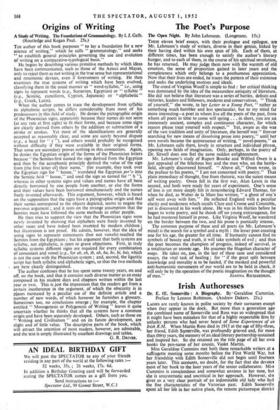Origins of Writing
A Study of Writing. The Foundations of Grammatology. By I. J. Gelb. (Routledge and Kegan Paul. 25s.) THE author of this book purposes " to lay a foundation for a new science of writing," which he calls " grarnmatology," and seeks " to establish general principles governing the use and evolution of writing on a comparative-typological basis." He begins by describing various primitive methods by which ideas have been communicated, such as those of the Aztecs and Mayas, only to reject them as not writing in the true sense but representational and mnemonic devices, even if forerunners of writing. He then examines the true systems of writing which have been evolved, classifying them in the usual manner as " word-syllabic," i.e., using signs to represent words (e.g., Sumerian, Egyptian) or " syllabic " (e.g., Semitic, cuneiform, Cypriot, Japanese) or " alphabetic " (e.g., Greek, Latin). When the author comes to trace the development from syllabic to alphabetic scripts, he differs considerably from most of his predecessors in this field of study. He denies the pictographic origin of the Phoenician signs, apparently because their names do not seem (at any rate at first sight) to fit their forms, and because some signs are clearly derived from others by the addition or subtraction of a stroke or strokes. Yet most of the identifications are generally accepted as reasonably clear, and some are surely beyond dispute (e.g., a head for " r "), and others would probably be recognised without difficulty if they were available in their original forms. That some are secondary proves nothing.in this connection. Again, he denies the Egyptian origin of the forms of the Phoenician letters because "the Semites first named the sign derived from the Egyptian and then by the acrophonic principle derived the value of the sign from (the first letter of] their name," (for example, they took over the Egyptian sign for house," translated the Egyptian per'o into the Semitic beth " house," and used the sign so named for " b "), whereas in other systems signs and values and names have all been directly borrowed by one people from. another, or else the forms and their values have been borrowed simultaneously and the names freely invented afterwards. This argument, however, which is based on the supposition that the signs have a pictographic origin and that their names correspond to the objects depicted, seems to negate the previous argument; and it rests on the strange assumption that the Semites must have followed the same methods as other people.
He then tries to support the view that the Phoenician signs were newly invented by showing that alphabets were freely invented by other races and have indeed been invented by modern children ; but illustration is not proof. He admits, however, that the idea of using signs to represent consonants (but not vowels) reached the Semites from the Egyptians ; but his argument that both systems are syllabic, not alphabetic, is open to grave objections. First, in truly syllabic systems different signs are required for every combination of consonant and vowel (e.g., for ab, eb, ib, ub, ba, be, bi, bu), which is not the case with the Phoenician system ; and, second, the ligaritic script has both syllabic and alphabetic signs, so that the two methods are here clearly distinguished.
The author confesses that he has spent some twenty years, on and off, on the book, and that it contains such diverse matter as an essay composed in his student days and chapters written within the last year or two. This is just the impression that the readers get from a certain incoherence in the argument, of which the obscurity is in places increased by a peculiar use of the definite article and a number of new words, of which however he furnishes a glossary. Sometimes too, no conclusions emerge ' • for example, the chapter entitled " Monogenesis or Polygenesis of Writing " leaves it quite uncertain whether he thinks that all the systems have a common origin and have been separately developed. Others, such as those on " Writing and Civilisation " and on its future development, are slight and of little value. The descriptive parts of the book, which will attract the attention of most readers, however, are admirable, and the text is amply illustrated by excellent drawings and tables.
G. R. DRIVER.


























 Previous page
Previous page